|
|
|
Sort Order |
|
|
|
Items / Page
|
|
|
|
|
|
|
| Srl | Item |
| 1 |
ID:
182778


|
|
|
|
|
| Summary/Abstract |
In this paper, I examine the causal impact of college education on young adults' out-province migration in China using China Family Panel Studies 2010 wave data. I use the number of colleges at the province-year level to identify the effect of college attendance on young adults' later life location choice. 2SLS estimates suggest that attending college significantly increases the likelihood of residing in a different province later in life by 7.5 percentage points. A series of tests shows that the impact of college on migration is heterogenous to people's childhood location, gender, hukou origin, and occupation.
|
|
|
|
|
|
|
|
|
|
|
|
|
|
|
|
| 2 |
ID:
178025
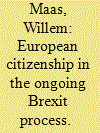

|
|
|
|
|
| Summary/Abstract |
Although traumatic, the ongoing Brexit process does not fundamentally alter either the legal status of European citizenship or the debates about it within the European Union (EU). Citizenship and free movement are so fundamental to the European project that even the new status of an important state like the UK does not change the political dynamics surrounding them.
|
|
|
|
|
|
|
|
|
|
|
|
|
|
|
|
| 3 |
ID:
178631


|
|
|
|
|
| Summary/Abstract |
Conscription typically involves migration to the duty base location. According to DaVanzo’s theory of repeat migration, this military-motivated migration might foster post-military migration. This paper investigates this issue empirically using individual-level data drawn from the 1992, 1998, and 2001 editions of the French survey of labor market entrants ‘Génération.’ The methods used to identify the causal effect of compulsory peacetime conscription on the post-military propensity to migrate exploit the abolition of conscription in France in October 1997 plus information on the timing of service among those who served. Conscription stimulated the post-military propensity to migrate for work of French male labor-market entrants with upper-class origins. Furthermore, there is evidence of a previously overlooked anticipatory effect of conscription: French males who were waiting to be called up for military service were approximately 25% less likely to migrate for work than comparable non-conscripts. Some implications of these findings and a consideration of their external validity are also provided.
|
|
|
|
|
|
|
|
|
|
|
|
|
|
|
|
| 4 |
ID:
116072


|
|
|
|
|
| Publication |
2012.
|
| Summary/Abstract |
This article addresses temporary labour migration - known in Russian as otkhodnichestvo (going away on foot) - from the Russian republic of Dagestan. The discussion is situated within reviews of current work on migration in the former Soviet Union, push-pull factors determining migration behaviour in the North Caucasus, and the historical importance of otkhodnichestvo in imperial Russia and the USSR. The paper then turns to the results of a census conducted in summer 2006, which found that most migrants come from Dagestan's mountainous southwest, frequently obtain work at locations characterized by economic growth and high pay, and rely on ethnic or communal networks as a basis for choosing employment sector and destination when searching for work.
|
|
|
|
|
|
|
|
|
|
|
|
|
|
|
|
| 5 |
ID:
174021


|
|
|
|
|
| Summary/Abstract |
This study examines threat perception amongst internal migrant groups in Turkey by proposing the ‘hometown cluster-based intergroup threat model.’ It contributes to the existing literature in two important respects. First, this study generates hometown clusters by measuring the social distance between migrants. Second, four dimensions of threat perception – culture, language, religion, and economics – are analyzed to reveal the development of conflict amongst internal migrant groups. The results reveal that in Gebze, a city inhabited mostly by migrants, threat perceptions are activated by both hometown clusters and ethno-religious identities.
|
|
|
|
|
|
|
|
|
|
|
|
|
|
|
|
| 6 |
ID:
159070


|
|
|
|
|
| Summary/Abstract |
China provides a unique experience of massive internal (within-country) migration but with high segregation of jobs between migrants and natives. Thus, migration has a complementary external effect on native wages: the elasticities of complementarity of migrants are about 31.7%, 20.3%, and 19.9% for native workers with a college, high school and less than high school education, respectively. After the wage is deflated by the housing price, the elasticities decline to 11%, 8.2% and −4.4% for the respective education groups, which provides the lower-bound analysis results. In addition, migration has widened wage dispersion, as well as increasing the education premium and residual inequality. The elasticity of substitution in jobs between migrants and natives is very low due to the hukou restriction, and increasing proportions of migrants in any given labor force widen the migrant/native wage gap. Job segregation is an important factor that explains particular labor market findings in China.
|
|
|
|
|
|
|
|
|
|
|
|
|
|
|
|
| 7 |
ID:
192965
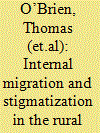

|
|
|
|
|
| Summary/Abstract |
Eastern Europe has seen considerable social, economic and political upheaval since 1989. Migration has been an important element of this change, with the removal of restrictions enabling individuals to move in search of opportunities. Resulting patterns of internal migration rest on a longer history of movement, linked to the communist-era pursuit of economic development and modernization. Proximity to Western Europe has seen some regions receive greater migrant flows, leading to resentment and distancing among the resident population. Focusing on rural settlements in the Banat region, southwestern Romania, this article examines how receiving communities perceive the effects of internal migration. The findings suggest entrenched stereotypes established during the communist-era remain prominent in patterns of stigmatization and maintenance of social distance. They also point to underlying tensions between the desire to protect local culture and tradition, while ensuring the continued viability of small settlements in the face of threats of depopulation.
|
|
|
|
|
|
|
|
|
|
|
|
|
|
|
|
| 8 |
ID:
127651


|
|
|
|
|
| Publication |
2014.
|
| Summary/Abstract |
Spontaneous and organized population movements have long been used as a means of promoting a country's goals of development and national integration. At the local level, on the other hand, these movements have frequently done the opposite, fueling local grievances, sharpening group distinctions, and at times creating 'sons-of-the-soil' conflicts. In this paper, I explore this apparent tension between the national political rationale for internal migration and the political impact such migration has had locally, in four minority regions of China and Indonesia. I argue that the specific manner in which migration affects local politics is influenced by a country's political regime. In Indonesia, the impact of migration is observed in electoral politics, where 'politics of place' have been allowed to emerge. In China, it is perceived in the curbing of national minorities' territorial autonomy. The role played by local elites and group competition between indigenous people and migrants are also reviewed.
|
|
|
|
|
|
|
|
|
|
|
|
|
|
|
|
| 9 |
ID:
079866


|
|
|
|
|
| Publication |
2007.
|
| Summary/Abstract |
This article compares Soviet with post-Soviet migration trends. It uses a livelihood studies approach to explore what types of Russians migrate and their motivations for so doing. It concludes that today labour migration is the most significant type of internal migration. The norm is temporary migration by individuals, which may be either short-term or long-term, but in either case it is characterised by frequent visits home and often, it seems, by failure and permanent return.
|
|
|
|
|
|
|
|
|
|
|
|
|
|
|
|
| 10 |
ID:
166880
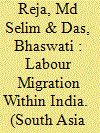

|
|
|
|
|
| Summary/Abstract |
Large-scale interstate labour migration within India is facilitated by the freedom of movement for citizens within this huge nation state. However, such internal labour migration within India remains largely unstudied and offers huge scope for gaining significant new knowledge. Focusing particularly on migrant construction workers from West Bengal moving to Kerala, this article specifically examines the motivations of these migrants and the role of social networks in the development of such migration streams. A field survey in Kerala indicates that Kerala’s Gulf connection and rapid demographic transition have resulted in significant reduction of local supplies of labour, thus attracting more migrants from other states in India due to better job opportunities, higher wages and good payment systems. Networks within migrant groups, especially friends’ contacts, are found to be the strongest factor in supporting this migration process.
|
|
|
|
|
|
|
|
|
|
|
|
|
|
|
|
| 11 |
ID:
103853
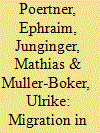

|
|
|
|
|
| Publication |
2011.
|
| Summary/Abstract |
In Nepal, international labor migration to India and overseas, as well as internal migration to the rural Nepalese lowlands, is of high socioeconomic significance. Scholarly debates about migration in Nepal have gradually shifted from an economic to a more holistic perspective, also incorporating social dimensions. However, little evidence has been generated about internal migration to urban destinations and the potential linkages between international and internal migration. This article draws on Bourdieu's "Theory of Practice" and sees migration as a social practice. Accordingly, migration practice is regarded as a strategy social agents apply to increase or transfer capitals and ultimately secure or improve their social position. Evidence for this argument is based on a qualitative case study of ruralto- urban migrants in Far West Nepal conducted in July and August 2009. The study at hand addresses linkages between internal and international migration practices and provides insight about a social stratum that is often neglected in migration research: the middle class and, more precisely, government employees. The authors show that social relations are crucial for channeling internal migration to a specific destination. Furthermore, they unveil how internal migration is connected to the international labor migration of former generations. Finally, the authors examine how migration strategies adopted over generations create multi-local social networks rooted in the family's place of origin.
|
|
|
|
|
|
|
|
|
|
|
|
|
|
|
|
| 12 |
ID:
185089


|
|
|
|
|
| Summary/Abstract |
This article explores the rise of Christianity in urban Nepal through the lens of rural to urban migrants and their experiences. As Christianity continues its exponential growth in the Kathmandu Valley, especially among socially and culturally marginalized groups, the article provides theoretical indicators of what is driving the phenomenon. The article explores the motivations for Christian conversion through a comparative methodology: it compares rural-to-urban migrants who converted to Christianity with those who did not and remained Hindu. Interviews with these two groups (conducted from 2018 to 2021) open a window onto the perceived benefits of Christian conversion. The empirical findings are framed through sociological theories of conversion. Interviews show that Christian conversion in urban Nepal is associated with the development of new forms of sociality that assist newcomers to the city adjust to a larger, more anomic environment. Survey findings are supplemented by reports of Christian worship services from various churches in the Kathmandu Valley. The article ends by exploring possible reactions from mainstream Hinduism in Nepal, arguing that Hinduism in Nepal has not yet evolved in the direction of India’s populist hindutva but that among the professional classes personalistic forms of Hindu belief are flourishing.
|
|
|
|
|
|
|
|
|
|
|
|
|
|
|
|
| 13 |
ID:
178645
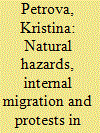

|
|
|
|
|
| Summary/Abstract |
Does internal migration following natural hazards increase the likelihood of protests in migrant-receiving areas? To address the question, this study first looks at the extent to which experiencing different forms of natural hazards contributes to a household’s decision to leave their district of residence. In a second step, the article explores whether that internal migration flow increases the number of protest events in migrant-hosting districts. In doing so, it contributes to the existing debate on the extent to which natural hazards impact the likelihood of social contention, and the role of migration as a linking pathway in that relationship. The impact of climate-related shocks may erode household assets and therefore adaptive capacity in ways that can eventually influence decisions to migrate to larger urban centres. Although migrants are agents of economical and technological change, urban environments may impose challenges to recently arrived migrants and their host communities, affecting the motivations and mobilization resources of urban social groups to protest. As a consequence, the probability of urban unrest in these locations is expected to increase. To test this, I use geo-referenced household-level data from Bangladesh for the period 2010–15, which records households’ experiences of different forms of natural hazard and internal migration flows, available from the Bangladesh Integrated Household Survey. It combines this with data on protests, derived from the Armed Conflict Location and Event Data. Findings suggest that flood hazards in combination with loss of assets increase the likelihood of internal migration, but unlike other types of domestic mobility, hazard-related migration does not increase the frequency of protests in migrants’ districts of destination.
|
|
|
|
|
|
|
|
|
|
|
|
|
|
|
|
| 14 |
ID:
158901


|
|
|
|
|
| Summary/Abstract |
Three decades since the first wave of rural–urban migration, the new generation of migrant workers has become the main force of internal migration in China. The present paper comprehensively explores the profiles of the new generation of migrant workers in urban China. We find that the “new generation” migrants are more educated and skilled, and are likely to work in manufacturing and service industries than in the construction industry. Moreover, they tend to allocate more time to non‐farm activities and have more months away from home per year in urban areas. In contrast to their predecessors, they tend to migrate to urban areas with their spouses, consume more in urban areas and send less money back home. Our findings suggest that the differences in features between the new generation of rural migrants and urban residents have become smaller and the integration of rural migrants into urban China has taken place gradually.
|
|
|
|
|
|
|
|
|
|
|
|
|
|
|
|
| 15 |
ID:
111891
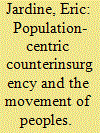

|
|
|
|
|
| Publication |
2012.
|
| Summary/Abstract |
The theory of population-centric counterinsurgency rests upon the untenable premise that the population within a theater of operations is fixed in place. By showing that people tend to move away from contested rural areas towards the relative safety and prosperity of counterinsurgent-controlled areas, this article demonstrates that this crucial premise is empirically false. Furthermore, a theory of counterinsurgent resource deployment, population movement, and incumbent strategic ineffectiveness is presented. Ultimately, the application of counterinsurgency resources actually dislocates the population from their place of residence and causes them to move into cities. When the urban areas' ability to absorb newcomers is overwhelmed, localized negative externalities emerge and can give rise to crime and insecurity. Such increased insecurity then creates an incentive for the counterinsurgency to retrench its resource use into the cities. As more physical territory is conceded to the insurgency, the relative strategic effectiveness of the counterinsurgency declines.
|
|
|
|
|
|
|
|
|
|
|
|
|
|
|
|
| 16 |
ID:
177789


|
|
|
|
|
| Summary/Abstract |
This article highlights emerging patterns of domestic remittance arrangements among migrant construction workers from West Bengal in Kerala that have now become defunct because of COVID-19. Earlier field surveys and in-depth interviews showed how Bengali migrant construction workers, relying on networks of friendship and trust, were learning to remit through formal channels, in contrast with many micro-studies showing the dominant role of informal channels in domestic remittances. High wage rates in Kerala enabled such migrant construction workers to send significant amounts, used for productive activities besides household expenses. However, there were significant changes in arrangements, before COVID-19 enforced a dramatic suspension of remittances, raising important questions about future possibilities.
|
|
|
|
|
|
|
|
|
|
|
|
|
|
|
|
| 17 |
ID:
079928
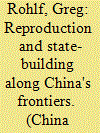

|
|
|
|
|
| Publication |
2007.
|
| Summary/Abstract |
This article analyzes population resettlement to western China during contemporary times within a historical framework that emphasizes gender. During the 1950s most relocatees to Qinghai were men, following the historical pattern set by Qing policies. Empirical data also show that the PRC government explicitly recruited women for relocation to border and remote areas. Women were moved to western regions as somewhat gender-neutral workers and also to serve in their traditional roles as wives and mothers. In both roles, women were a crucial component in state-building policies in border and remote areas. In fact, because sovereignty could not be permanently established without a naturally reproducing population, one can argue that reproduction was, and is, a basic component of state-building-an assertion that gets little attention in analyses of social and political change in border regions. This article describes the consolidation phase of territorial expansion as a feminine or yin process that relied upon incremental, organic growth, or "soft" assertions of power. Government documents, published materials, census records, and journalistic reporting are used to demonstrate these patterns and processes.
|
|
|
|
|
|
|
|
|
|
|
|
|
|
|
|
| 18 |
ID:
102250


|
|
|
|
|
| Publication |
2010.
|
| Summary/Abstract |
After two decades of rural-to-urban labour exodus, an increasing trend of urban-to-rural labour counterflow has also occurred in China*. This paper discusses the economic performance of return migrants with data from a survey conducted in Wuwei County in 2008. We identify the characteristics of return migrants, record their occupational change patterns, and examine their current self-employment activities. A comparative approach with non-migrants is used throughout the paper.
|
|
|
|
|
|
|
|
|
|
|
|
|
|
|
|
| 19 |
ID:
139604


|
|
|
|
|
| Summary/Abstract |
Challenging conventional wisdom, this article argues that Indonesia — long home to both large-scale transmigration programmes and a range of conflicts — has not witnessed transmigrant conflicts. The vast majority of Indonesian transmigrants were resettled in parts of Sumatra which have remained peaceful. In some conflicts, the role of transmigration has been exaggerated. In others, interethnic violence has involved spontaneous migrants rather than state-led transmigrants. We conclude with a discussion of two potential outliers, where violence has been directed towards transmigrants, but only those from disaster-affected regions who arrived en masse. This article argues for a more nuanced understanding of the distinctions between different forms of internal migration, some of which have the potential to spark future violence in recipient areas and communities.
|
|
|
|
|
|
|
|
|
|
|
|
|
|
|
|
| 20 |
ID:
166739
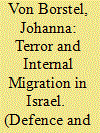

|
|
|
|
|
| Summary/Abstract |
This paper empirically analyses the effect of terror on internal migration between Israeli subdistricts. Using a unique data-set comprising migration flows for the period 1999–2012 and the number of rocket and non-rocket attacks, we test the hypotheses that terror reduces migration into an affected subdistrict and increases migration out of it. According to our results, the effect of terror on migration is asymmetric as we only find evidence for the first hypothesis. This result remains when we use an instrumental variables strategy that corrects for underreporting of the number of rocket attacks. The largest effects of rocket attacks are found for migration into the Southern subdistrict of Ashqelon as well as into other border regions in Northern Israel, while non-rocket attacks also have substantial effects in the more populous centres of Jerusalem and Tel Aviv.
|
|
|
|
|
|
|
|
|
|
|
|
|
|
|
|
|
|
|
|
|